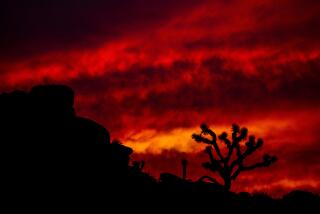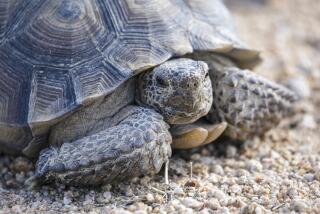To survive global warming, Mojave Desert birds will need a lot more water — and they probably won’t get it
Bird populations in the Mojave Desert have collapsed over the last century, and now scientists say they know why: The animals’ bodies can’t cope with the hotter and drier weather brought on by global warming.
The discovery, described this week in the Proceedings of the National Academy of Sciences, draws upon historical records and high-tech virtual bird modeling to explain how climate change has caused such drastic population losses — and how it will probably cause even deeper losses in the future.
“There’s just a huge and building scientific literature on how we’re screwing up biodiversity, and this is a really important contribution to it,” said Paul Ehrlich, an evolutionary ecologist at Stanford University who was not involved in the work.
As climate change and habitat destruction due to human activity continue across the globe, many species have found themselves in decline or under threat. A recent study in the journal Science, for instance, found that there are nearly 3 billion fewer birds in North America today than there were in 1970. A complex mix of factors could be to blame, including pollution and human encroachment on their habitats. But linking climate change to the decline of a specific species is often a tricky task.
Steven Beissinger, a conservation biologist at UC Berkeley, managed to find a clear connection in the Mojave. He and his colleagues have spent years surveying communities of birds that already live in an extreme environment: the deserts of California and other parts of the West, where temperatures rise well into triple digits in the hottest months.
Although California deserts have long provided a home for all manner of plants and animals, these ecosystems exist near the brink of what many of their resident species can handle. Turn up the heat, and it might just push them over the edge. While that’s bad news for the birds that live there, that quality makes it a useful place to study the effects of climate change.
The desert was also a good place to start because the researchers had more than a century’s worth of data on it, thanks to UC Berkeley ecologist Joseph Grinnell. Starting in 1904 and continuing for nearly four decades, Grinnell and his colleagues surveyed wildlife across many California biomes, providing a trove of historical data on the state’s small mammal and bird life.
As part of an effort to resurvey the communities Grinnell had documented, UC Berkeley postdoctoral researcher Kelly Iknayan revisited 61 remote sites in the Mojave Desert in California and Nevada, spending days at each one. She identified a menagerie of species, including the tiny Costa’s hummingbird, Gambel’s quail and large raptors such as the golden eagle.
She and Beissinger found that 39 of the 135 bird species that lived there a century ago were both less common and less widespread today. On average, those sites lost 43% of their species over the last 100 years. Those results were published in the Proceedings of the National Academy of Sciences last year.
“It’s quieter out there than it used to be,” Beissinger said.
Human encroachment could not explain the declines because many of the places they surveyed were in protected areas. But the researchers noticed a striking decline in rainfall — and that made them wonder if a lack of water could be to blame.
The scientists suspected that the rising temperatures meant the birds were no longer able to effectively cool their bodies. Birds, like humans, are endothermic: We maintain our internal temperatures by generating our own heat rather than relying on the environment.
The drawback is that we need good cooling mechanisms to avoid overheating. Both birds and humans use water to help remove that heat, though in different ways; humans sweat whereas birds pant and radiate it from their skin.
Thanks to climate change, the Mojave Desert has grown hotter by about 2 degrees Celsius (about 3.6 degrees Fahrenheit), on average, over the last century. This means birds would have higher “cooling costs” — that is, they would need to consume more water to radiate off more heat. Unfortunately for them, climate change has simultaneously made deserts drier — meaning that water became increasingly difficult to find just as the need for it rose.
To test this idea, lead author Eric Riddell, a UC Berkeley postdoctoral scholar, put his background in physics to work. He constructed a virtual bird model that allowed his team to simulate the cooling costs for 50 bird species. With help from specimens in UC Berkeley’s Museum of Vertebrate Zoology, the scientists tailored the models to different species of birds, taking into account their unique body size, shape and even the properties of their feathers, such as their reflectivity and ability to insulate.
Riddell placed the virtual birds in the virtual sun and shade, to see how their bodies reacted. As the virtual birds got hotter, the scientists could estimate how much water a bird would need to evaporate in order to cool down.
The scientists found that as the temperature rose, so did the birds’ cooling costs, by an average of 18.8%. Those increased costs dovetailed with the population declines seen over the last century.
Another pattern emerged as well: The increasing heat and aridity hit larger birds particularly hard because they need much more water than smaller birds to cool down. It’s also harder for larger birds to find sufficient shade to shelter their bodies from the sun. This could explain why the average body size of many bird species shrank, the scientists said. The species that did become smaller saved up to 14% in cooling costs and suffered less decline than species that remained the same size.
Birds that ate insects or other animals also fared worse than their herbivorous, seed-eating cousins, the scientists found. That’s probably because insectivores and carnivores don’t really drink water — they get their hydration directly from the critters they eat. And the hotter it is, the more water they need. This traps them in a vicious cycle: overheated birds would have to spend more time and energy in the hot sun hunting, probably increasing their cooling costs.
Seed-eating birds do drink water and thus fare better if they have some body of water nearby. But those are increasingly hard to find in a drying climate, the scientists said.
These are just the costs that desert birds have already suffered, Beissinger pointed out. Their situation will almost certainly grow worse. In the future, as the world heats up, those cooling costs will probably jump by 50% to 78% — and a paltry 14% rebate from body shrinkage won’t help much then.
North America has lost nearly 3 billion birds since 1970, and the continent has also seen widespread population declines among hundreds of bird species.
Many previous studies have examined animal physiology and made predictions about how species may be affected by climate change, said John Wiens, an evolutionary ecologist at the University of Arizona who was not involved in the work. But the new paper shows how animals’ physical limits have already been tested by global warming.
“It’s quite different,” Wiens said of the work.
California desert birds are probably not the only ones that will suffer these kinds of consequences, Wiens added. Deserts around the world are growing hotter and drier, and their avian residents may be suffering as a result.
Iknayan said the researchers plan to conduct a similar analysis with small-mammal populations, which Grinnell also surveyed.
“Unfortunately one of the big impacts of climate change is that a lot of places will become even more arid — so these principles might also apply more broadly,” Wiens said.
Ultimately, he said, the way to help birds is to address the underlying cause of their plight.
“The best thing to do is to stop climate change — or ameliorate it as much as possible,” he said.







